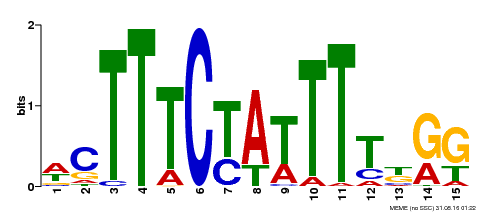- Alvarez-Buylla ER, et al.
MADS-box gene evolution beyond flowers: expression in pollen, endosperm, guard cells, roots and trichomes.
Plant J., 2000. 24(4): p. 457-66
[PMID:11115127] - Riechmann JL, et al.
Arabidopsis transcription factors: genome-wide comparative analysis among eukaryotes.
Science, 2000. 290(5499): p. 2105-10
[PMID:11118137] - Ratcliffe OJ,Nadzan GC,Reuber TL,Riechmann JL
Regulation of flowering in Arabidopsis by an FLC homologue.
Plant Physiol., 2001. 126(1): p. 122-32
[PMID:11351076] - Scortecci KC,Michaels SD,Amasino RM
Identification of a MADS-box gene, FLOWERING LOCUS M, that represses flowering.
Plant J., 2001. 26(2): p. 229-36
[PMID:11389763] - Pelaz S,Gustafson-Brown C,Kohalmi SE,Crosby WL,Yanofsky MF
APETALA1 and SEPALLATA3 interact to promote flower development.
Plant J., 2001. 26(4): p. 385-94
[PMID:11439126] - Michaels SD, et al.
AGL24 acts as a promoter of flowering in Arabidopsis and is positively regulated by vernalization.
Plant J., 2003. 33(5): p. 867-74
[PMID:12609028] - Scortecci K,Michaels SD,Amasino RM
Genetic interactions between FLM and other flowering-time genes in Arabidopsis thaliana.
Plant Mol. Biol., 2003. 52(5): p. 915-22
[PMID:14558654] - Oh S,Zhang H,Ludwig P,van Nocker S
A mechanism related to the yeast transcriptional regulator Paf1c is required for expression of the Arabidopsis FLC/MAF MADS box gene family.
Plant Cell, 2004. 16(11): p. 2940-53
[PMID:15472079] - Doyle MR, et al.
HUA2 is required for the expression of floral repressors in Arabidopsis thaliana.
Plant J., 2005. 41(3): p. 376-85
[PMID:15659097] - Werner JD, et al.
Quantitative trait locus mapping and DNA array hybridization identify an FLM deletion as a cause for natural flowering-time variation.
Proc. Natl. Acad. Sci. U.S.A., 2005. 102(7): p. 2460-5
[PMID:15695584] - de Folter S, et al.
Comprehensive interaction map of the Arabidopsis MADS Box transcription factors.
Plant Cell, 2005. 17(5): p. 1424-33
[PMID:15805477] - Lehti-Shiu MD,Adamczyk BJ,Fernandez DE
Expression of MADS-box genes during the embryonic phase in Arabidopsis.
Plant Mol. Biol., 2005. 58(1): p. 89-107
[PMID:16028119] - Kim SY, et al.
Establishment of the vernalization-responsive, winter-annual habit in Arabidopsis requires a putative histone H3 methyl transferase.
Plant Cell, 2005. 17(12): p. 3301-10
[PMID:16258034] - Balasubramanian S,Sureshkumar S,Lempe J,Weigel D
Potent induction of Arabidopsis thaliana flowering by elevated growth temperature.
PLoS Genet., 2006. 2(7): p. e106
[PMID:16839183] - Sung S,Schmitz RJ,Amasino RM
A PHD finger protein involved in both the vernalization and photoperiod pathways in Arabidopsis.
Genes Dev., 2006. 20(23): p. 3244-8
[PMID:17114575] - Li Y,Roycewicz P,Smith E,Borevitz JO
Genetics of local adaptation in the laboratory: flowering time quantitative trait loci under geographic and seasonal conditions in Arabidopsis.
PLoS ONE, 2006. 1: p. e105
[PMID:17205109] - Kuhn JM,Breton G,Schroeder JI
mRNA metabolism of flowering-time regulators in wild-type Arabidopsis revealed by a nuclear cap binding protein mutant, abh1.
Plant J., 2007. 50(6): p. 1049-62
[PMID:17488241] - Andersson CR, et al.
The FLX gene of Arabidopsis is required for FRI-dependent activation of FLC expression.
Plant Cell Physiol., 2008. 49(2): p. 191-200
[PMID:18156133] - Ascencio-Ib
Global analysis of Arabidopsis gene expression uncovers a complex array of changes impacting pathogen response and cell cycle during geminivirus infection.
Plant Physiol., 2008. 148(1): p. 436-54
[PMID:18650403] - Pouteau S, et al.
Diversification of photoperiodic response patterns in a collection of early-flowering mutants of Arabidopsis.
Plant Physiol., 2008. 148(3): p. 1465-73
[PMID:18799658] - Mathieu J,Yant LJ,Mürdter F,Küttner F,Schmid M
Repression of flowering by the miR172 target SMZ.
PLoS Biol., 2009. 7(7): p. e1000148
[PMID:19582143] - Balasubramanian S,Weigel D
Temperature Induced Flowering in Arabidopsis thaliana.
Plant Signal Behav, 2006. 1(5): p. 227-8
[PMID:19704664] - Laluk K,Mengiste T
The Arabidopsis extracellular UNUSUAL SERINE PROTEASE INHIBITOR functions in resistance to necrotrophic fungi and insect herbivory.
Plant J., 2011. 68(3): p. 480-94
[PMID:21749505] - Arabidopsis Interactome Mapping Consortium
Evidence for network evolution in an Arabidopsis interactome map.
Science, 2011. 333(6042): p. 601-7
[PMID:21798944] - Yun JY,Tamada Y,Kang YE,Amasino RM
Arabidopsis trithorax-related3/SET domain GROUP2 is required for the winter-annual habit of Arabidopsis thaliana.
Plant Cell Physiol., 2012. 53(5): p. 834-46
[PMID:22378382] - Khan MR,Khan IU,Ali GM
MPF2-like MADS-box genes affecting expression of SOC1 and MAF1 are recruited to control flowering time.
Mol. Biotechnol., 2013. 54(1): p. 25-36
[PMID:22539207] - Meinke DW
A survey of dominant mutations in Arabidopsis thaliana.
Trends Plant Sci., 2013. 18(2): p. 84-91
[PMID:22995285] - Lee JH, et al.
Regulation of temperature-responsive flowering by MADS-box transcription factor repressors.
Science, 2013. 342(6158): p. 628-32
[PMID:24030492] - Pos
Temperature-dependent regulation of flowering by antagonistic FLM variants.
Nature, 2013. 503(7476): p. 414-7
[PMID:24067612] - Hwan Lee J,Sook Chung K,Kim SK,Ahn JH
Post-translational regulation of short vegetative phase as a major mechanism for thermoregulation of flowering.
Plant Signal Behav, 2014. 9(3): p. e28193
[PMID:24614351] - Hwan Lee J,Sook Chung K,Kim SK,Ahn JH
Post-translational regulation of SHORT VEGETATIVE PHASE as a major mechanism for thermoregulation of flowering.
Plant Signal Behav, 2014. 9(4): p. e28193
[PMID:25764420] - Luo M, et al.
Regulation of flowering time by the histone deacetylase HDA5 in Arabidopsis.
Plant J., 2015. 82(6): p. 925-36
[PMID:25922987] - Airoldi CA,McKay M,Davies B
MAF2 Is Regulated by Temperature-Dependent Splicing and Represses Flowering at Low Temperatures in Parallel with FLM.
PLoS ONE, 2015. 10(5): p. e0126516
[PMID:25955034] - Lutz U, et al.
Modulation of Ambient Temperature-Dependent Flowering in Arabidopsis thaliana by Natural Variation of FLOWERING LOCUS M.
PLoS Genet., 2015. 11(10): p. e1005588
[PMID:26492483] - Sureshkumar S,Dent C,Seleznev A,Tasset C,Balasubramanian S
Nonsense-mediated mRNA decay modulates FLM-dependent thermosensory flowering response in Arabidopsis.
Nat Plants, 2016. 2(5): p. 16055
[PMID:27243649] - Lutz U, et al.
Natural haplotypes of FLM non-coding sequences fine-tune flowering time in ambient spring temperatures in Arabidopsis.
Elife, 2018.
[PMID:28294941] - Capovilla G,Symeonidi E,Wu R,Schmid M
Contribution of major FLM isoforms to temperature-dependent flowering in Arabidopsis thaliana.
J. Exp. Bot., 2017. 68(18): p. 5117-5127
[PMID:29036339] - Ahn CS,Lee DH,Pai HS
Characterization of Maf1 in Arabidopsis: function under stress conditions and regulation by the TOR signaling pathway.
Planta, 2019. 249(2): p. 527-542
[PMID:30293201]
|





